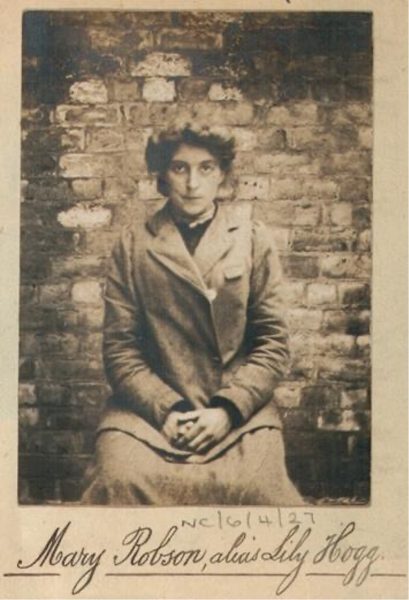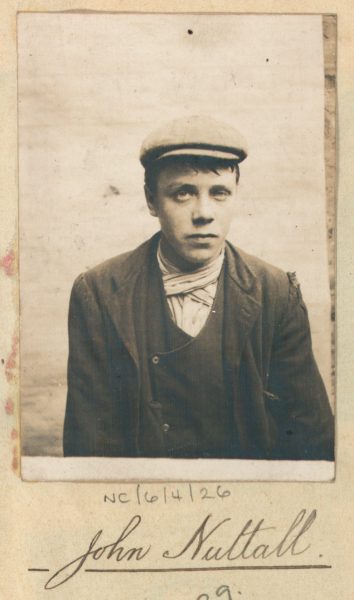Photographs of Mary Robson and John Nuttall, 1907
Reference: NC/6/4/26 & NC/6/4/27
Suggested age groups: KS1, KS2, KS3, KS4, lifelong learners
Subject areas: History, Literacy, Art, Maths
CONTEXT
In 1839 Parliament passed the County Police Act, which allowed counties to establish their own police forces. Northumberland first had a police force, or constabulary, in 1857.
Portraits like this were taken in police stations across the country so that policemen could identify criminals. In a time before personal identification documents, it was easy for people to adopt another name, or alias. Mary Robson also called herself Lily Hogg. John Nuttall and Mary Robson were both noted as being guilty of shop-breaking – breaking into shops and stealing from them – in this album of photographs.
During the eighteenth and nineteenth centuries some scientists suggested that a person’s face could be used to interpret their character. This “science” was called physiognomy and although it was widely discredited in the nineteenth century, many of its ideas remained popular into the early twentieth century (see link to “A Practical Character Reader”.) The registers of mental hospitals in the nineteenth century often contain photographs of the inmates.
A Newcastle Evening Chronicle article dated 8 January 1907 sheds a little more light on Mary’s life. According to the newspaper, Mary often posed as Lily Hogg and used this alias to obtain shoes, food and lodging “under false pretenses”. She lied to Dorothy Bloomfield, aged 83, of North Shields, so that she would have food and somewhere to stay. May/Lily told Dorothy that she would pay her rent from the wages that she earned at a laundry. When the police investigated they found that Mary/Lily had never worked there. She used a similar trick to get two pairs of shoes from Esther Black of Chirton. She said that she would pay for the “slippers”, which were worth 5s 11d (about £20 in 2020), from her pay as a barmaid at Victoria Hotel in North Shields.
The article states that Mary/Lily was already serving six months in Newcastle Gaol for three other crimes (house-breaking and two counts of larceny). Another four months was added to the sentence that she was already serving.
The Newcastle Daily Chronicle of 29 June 1907 included a report on the theft of 96lbs (43.5kg) of
scrap metal worth £5 (about £400 in 2020) In Wallsend. John Nuttall had already been convicted of stealing the scrap and was standing as a witness at the trial of the two older men who bought the copper and brass. The newspaper article states that William Miller was a “hawker” (someone who bought and sold things) and William Monsey was a marine-store dealer (someone who bought and sold things to do with ships).
“John Nuttall, one of the lads convicted of stealing the scrap, stated that he met Miller, and told him about the scrap, and asked him to buy it. Witness [John] wanted 25s for it, and Miller said he would give him a sovereign. Miller then went off to Monsey to borrow a sovereign, and both came back with a cart. Monsey asked witness where he had got the scrap, and witness said ‘It is all right’. Miller asked no questions. He received £1 from Miller for the metal.”
Photography was still a fairly recent technology. Until the beginning of the twentieth century equipment was bulky and expensive. It could only really be afforded by the wealthy or by professional photographers (like the photographer who took this picture).
ACTIVITIES
ACTIVITY 1
Background
Photographs of criminals in this time period were taken for two reasons: for identification and to support ideas of physiognomy. According to the theory of physiognomy, people were born as criminals, and criminals could be identified by their physical features.
SEE
See: Look at the photographs of John Nuttall and Mary Robson. Note down anything in the photographs that might give them away as criminals.
THINK
Think: Prisoners were photographed as soon as they arrived at the jail, so their mugshots often reflect their social status. Why might this lead to similarities between the appearance of criminals?
Think: Think about characters in literature and film: what can we learn about them from how they look? Teachers could connect this to the book currently being studied in Literacy.
DO
Do: Look up some of the features that physiognomy said were criminal traits. Draw a portrait of a criminal based on descriptions of these physical traits and label the traits.
Do: Look at the people around you: what do their physical features say about them according to physiognomy?
Resources
ACTIVITY 2
Background
John Nuttall and Mary Robson were both accused of shop-breaking – breaking into shops and stealing from them. A large amount of crimes at this time were committed due to poverty, and an increase in child criminals was observed. This led to changes in how child criminals were punished.
SEE
See: What crimes did Mary Robson commit?
See: What crime did John Nuttall commit?
See: Why was Mary already serving time in gaol?
See: How much was the scrap metal worth that was stolen?
THINK
Think: Look at the photographs of John and Mary. Why might they have been shop-breaking?
Think: What ways would children such as John and Mary be punished for this crime? How might this differ from how children today would be punished for this crime?
Think: How old do you think John and Mary were? Were people then considered to be children up to the same age as we consider people to be children now?
Think: What types of currency were used during this time?
Think: Can you find out what the currency s and d mentioned in the article about Mary Robson means?
Think: How has the value of currency changed since this time?
DO
Do: Research the ways that an increase in child criminals led to a change in how children were punished to separate them from adult criminals.
Do: In groups debate whether or not more should have been done to separate the ways adult and child criminals were punished.
Do: Using the information from the Newcastle Chronicle articles about Mary and John, write a newspaper article about John or Mary and their crimes.
Do: Use a currency convertor to work out how much the money mentioned in the newspaper articles about John and Mary is worth today.
Resources
ACTIVITY 3
Background
One of the purposes of photographing criminals was so that policemen could identify them. As this was in a time before personal identification documentation, it was easy for people to adopt another name, or alias.
SEE
See: Look at the photograph of Mary Robson. What was her alias?
See: What did Mary use her alias for?
THINK
Think: Discuss the reasons why people might have used an alias during this time.
Think: How important is your name to you? Do you think taking an alias would affect your sense of identity?
DO
Do: Write a diary entry as though you are Mary after she has been arrested. Consider what she might have been feeling or thinking during this time and what might have led her to commit the crime.
Do: Think of some early twentieth century names that you might have used if you took an alias.
Resources
OTHER ONLINE RESOURCES
The National Archives education website, page about provincial police forces:
https://www.nationalarchives.gov.uk/education/candp/prevention/g08/g08cs3.htm
Public Domain Review website, page with digital copy of “A Practical Character Reader” by L A
Vaught: https://publicdomainreview.org/collection/vaught-spractical-character-reader-1902
Old Police Cells Museum, Brighton website, page on
physiognomy: https://www.oldpolicecellsmuseum.org.uk/content/learning/that-criminal-look
Thought Co. website, page with history of photography
timeline: https://www.thoughtco.com/photography-timeline-1992306



